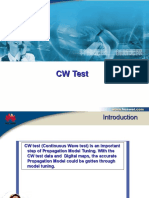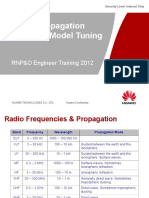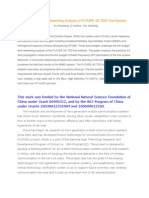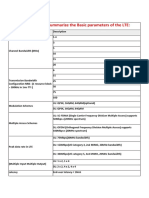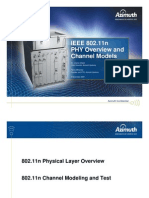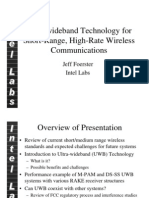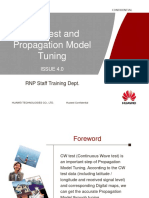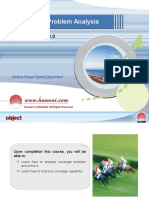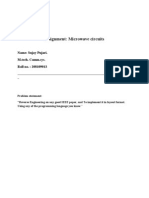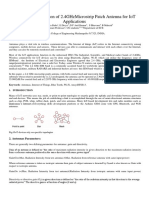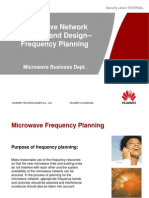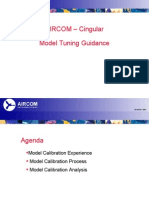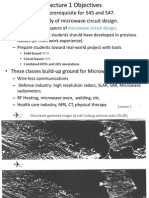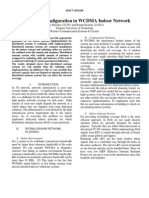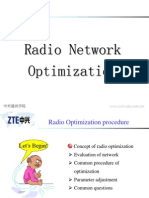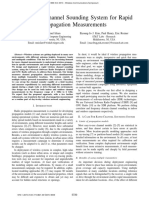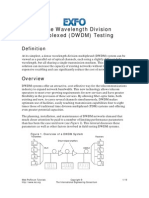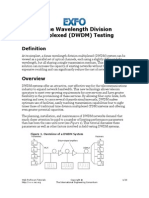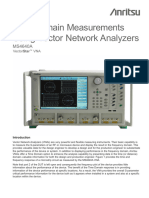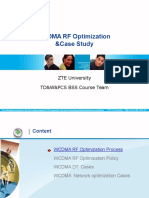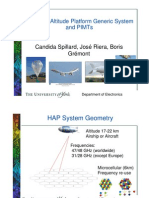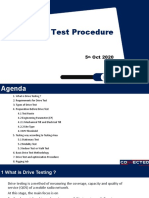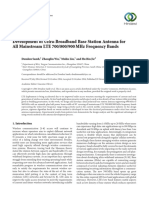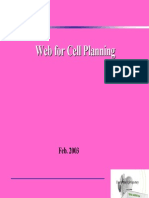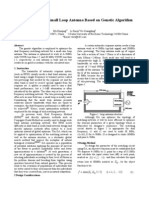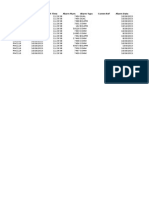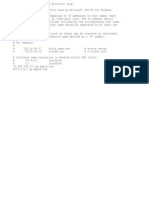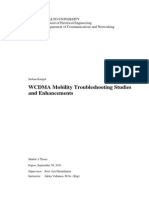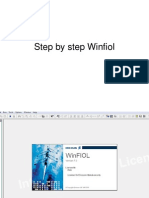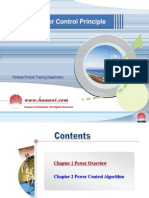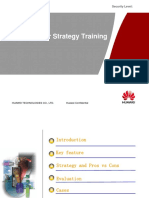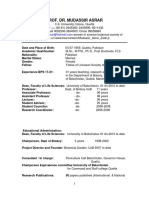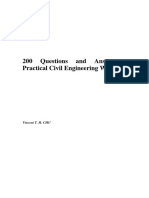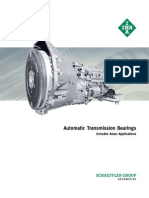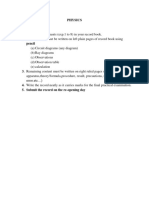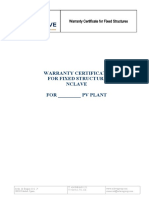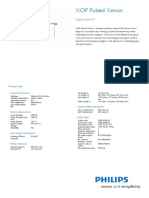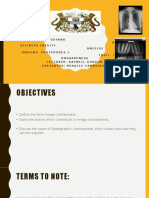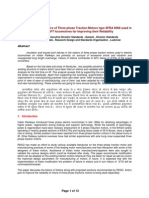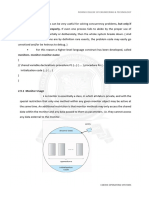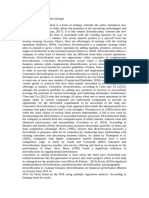CW Test: Huawei Confidential. All Rights Reserved
CW Test: Huawei Confidential. All Rights Reserved
Uploaded by
FachrudinSudomoCopyright:
Available Formats
CW Test: Huawei Confidential. All Rights Reserved
CW Test: Huawei Confidential. All Rights Reserved
Uploaded by
FachrudinSudomoOriginal Description:
Original Title
Copyright
Available Formats
Share this document
Did you find this document useful?
Is this content inappropriate?
Copyright:
Available Formats
CW Test: Huawei Confidential. All Rights Reserved
CW Test: Huawei Confidential. All Rights Reserved
Uploaded by
FachrudinSudomoCopyright:
Available Formats
Huawei Confidential.
All Rights Reserved
CW Test
1.0
Internal Use
Introduction
CW test (Continuous Wave test) is an important step
of Propagation Model Tuning. With the CW test
data and Digital maps, the accurate Propagation
Model could be gotten through model tuning.
Internal Use
Table of Contents
Training.huawei.com
Chapter 1 Principles and Purpose of CW
Test
Chapter 2 CW Test Workflow
Chapter 3 Analysis of CW Test Data
Internal Use
Principles and Purpose of CW test
Section 1 Propagation Models
Section 2 Principles of
Propagation Model Tuning
Section 3 Purpose of CW Test
Section 4 Basic Principles of CW
Test
Internal Use
Propagation Models
) (dB log 20 log 20 45 32 ) (f ) (d . L
MHz km fs
Free space propagation model
Statistical propagation model
Internal Use
Principle and Purpose of CW Test
Section 1 Propagation Models
Section 2 Principles of
Propagation Model Tuning
Section 3 Purpose of CW Test
Section 4 Basic Principles of CW
Test
Internal Use
Radio Propagation Model
Propagation model is used to predict the effect of terrain,
obstacle and artificial environment on the path loss.
WCDMA common propagation models
Internal Use
Okumura/Hata model
For: 900M2000MHz
COST231-Hata model
For: 1500-2000MHz
COST231 Walfish-Ikegami model
For: 800M-2000MHz
Keenan-Motley model
For indoor propagation
Propagation model in UNET
For macro cell on 300M2000M
Common propagation models
Radio Propagation Model
Internal Use
Radio Propagation Model
L=K1 + K2log(d) + K3log(HTxeff) + K4Diffraction
+ K5log(d)log(HTxeff) + K6(HRxeff) + Kclutterf(clutter)
K1: constant (dB)
K2: multiplier factor of log(d)
d: distance between Tx antenna and Rx antenna (m)
K3: multiplier factor of log(HTxeff)
HTxeff: effective height of Tx antenna (m)
K4: multiplier factor of diffraction loss, which must be a positive value
Diffraction loss: diffraction loss through the path with barriers (dB)
K5: multiplier factor of log(HTxeff)log(d)
K6: multiplier factor of HRxeff
HRxeff : effective height of Rx antenna (m)
Kclutter: multiplier factor of for f(clutter)
f(clutter): average weighted loss caused by clutter
Model in UNET:
Internal Use
Principle and Purpose of CW Test
Section 1 Propagation Models
Section 2 Principles of
Propagation Model Tuning
Section 3 Purpose of CW Test
Section 4 Basic Principles of CW
Test
Internal Use
Purpose of CW Test
Compare CW test data
with prediction results,
and then tune the
propagation parameters
to improve the accuracy
of coverage prediction.
GPS
Internal Use
Theory and Purpose of CW Test
Section 1 Propagation Models
Section 2 Principles of
Propagation Model Tuning
Section 3 Purpose of CW Test
Section 4 Basic Principles of CW
Test
Internal Use
Basic Principle of CW Test
Typification
The CW test data must represent the characteristic of
electromagnetic wave in this area.
Balance
The CW test data must represent the characteristic of
electromagnetic wave by the proportion of different
clutters in this area.
Internal Use
Table of Contents
Training.huawei.com
Chapter 1 Theory and Purpose of CW Test
Chapter 2 CW Test Workflow
Chapter 3 Analysis of Test Data
Internal Use
CW Test Workflow
Section 1 Site Selection
Section 2 Building Test
Platform in Networking
Section 3 Drive Test
Internal Use
Site Selection
Principles of site selection
Number of sites: It is usually agreed that a minimum of 5 sites should
be tested in large and dense city, but one site is enough in the city,
which mainly depends on antenna height and EIRP.
Representation: Site selection should aim to cover all types of clutter
(from the digital map) in the coverage zone.
Multiple models: Define the corresponding zone of each model if the
test environment requires multiple models to describe its propagation
characteristics.
Overlap: Increase measurement overlap area between each site as
much as possible. But reasonable inter-site distance should be ensured.
Obstacle: The data should be filtered in the subsequent processing if
obvious obstacle exists.
Internal Use
Site Selection
Standards of site selection
a. Antenna height should be greater than 20m.
b. The antenna should be 5m higher than the nearest obstacle.
c. The obstacle mainly refers to the highest building on the roof
where the antenna is installed. The building where the site is
located should be higher than average height of surrounding
buildings.
5
m
Internal Use
CW Test Workflow
Section 1 Site Selection
Section 2 Building Test
Platform in Networking
Section 3 Drive Test
Internal Use
Building Test Platform in Networking
Tx subsystem: Tx antenna, feeder, high-frequency signal source and
antenna holder
Rx subsystem: test receiver, GPS receiver, test software and laptop
High frequency signal
source
Signal source
TMA
Power supply
Tx antenna
Rx antenna
Drive test
instrument
Build-in GPS
Laptop
RF cable 1 RF cable 2
Internal Use
Building Test Platform in Networking
Record the gain of the following parts on signals during
networking:
Tx power of signal source
Loss of RF cable
Gain of Tx antenna
Gain of Rx antenna
Internal Use
CW Test Workflow
Section 1 Site Selection
Section 2 Building Test
Platform in Networking
Section 3 Drive Test
Internal Use
Drive Test
Keep to the following standards to select a test path
Landform: The test route must cover all main landforms in the area.
Height: The test route must cover landforms with different height in
this area if the landforms are up-and-down.
Distance: The test route must cover different positions from the
site in the area.
Direction: The test points must be consistent on the horizontal and
vertical route.
LengthThe total distance of one CW test should be longer than
60km.
Number of test points: The more, the better.
Overlap: Overlap the test route in different sites as much as
possible to improve the reliability of models.
Obstacle: Shadow areas behind this wall should be avoided when
antenna signals are obstructed by the wall at a side.
Internal Use
Drive Test
Lee criteria for sampling: 50 samples by 40
The maximum vehicle speed: V
max
=0.8/Tsample
Delete test results from the sampled data under abnormal conditions:
Fading over 15~30db without reasonable causes
In tunnels
Under the viaducts
Select test routes from the main lobe coverage area if directional
antennas are adopted for a CW test.
Internal Use
Table of Contents
Training.huawei.com
Chapter 1 Theory and Purpose of CW Test
Chapter 2 CW Test Workflow
Chapter 3 Analysis of Test Data
Internal Use
Analysis of Test Data
Section 1 Data Filtering
Section 2 Data Dispersion
Section 3 Data Binning
Section 4 Format
Conversion
Internal Use
Data Filtering
Data to be filtered is as follows:
1.
Data tested in the places where
GPS is unable to locate
accurately (such as under the
overhead rack, in the tunnel).
2.
Data obtained when the
distance to antenna is too near
or far.
3. Data obtained with too weak
signals.
4.
Error data caused by inexact AP
(antenna pattern).
5.
Other data inconsistent with the
requirements during the route
design of CW test.
Internal Use
Analysis of Test Data
Section 1 Data Filtering
Section 2 Data Dispersion
Section 3 Data Binning
Section 4 Format
Conversion
Internal Use
Data Dispersion
Propagation in mobile communications can be indicated as
follows:
r(x) = m(x)r
0
(x)
X: distance
r(x): received signals
r
0
(x): Raileigh Fading
m(x): local mean value, the combination of long-term fading
and space propagation loss
2L: average length between sampling areas, also called
intrinsic length
L x
L x
dy y r
L
x m ) (
2
1
) (
Internal Use
Data Dispersion
The CW test is to obtain the local mean value of each geography
location in some areas as far as possible, i.e. the difference of r(x) and
m(x) should be the minimum value. In this sense, effect of Raileigh
Fading should be excluded.
When the intrinsic length equals 40 wavelength and the number of
sampling points is 50, the difference of test data and actual local mean
value can be less than 1dB according to Lee criteria.
Intrinsic length is average length for binning (2G band is 6 m long,
namely, 40 wavelength)
Since the locating speed of GPS is far lower than the receiving speed
of the receiver, the dispersion processing is required before the
binning.
Internal Use
Data Dispersion
The principle of dispersion processing is as follows:
Conditions:
There are many test records arranged under each
locating point in time sequence because the receiving
speed of the receiver is far higher than the locating
speed of GPS.
The vehicle speed between two locating points is
uniform.
The time interval between every two measurement
records is the same.
Processing:
Equally distribute these records to the route section
between two points in time sequence so that there will
be sufficient points in every 6m range on test route.
Internal Use
Analysis of Test Data
Section 1 Data filtering
Section 2 Data Dispersion
Section 3 Data Binning
Section 4 Format
Conversion
Internal Use
Data Binning
Objectives:
Reserve the impact of slow fading but eliminate the fast fading
Methods:
Method 1: make grids for the whole area with 6m side, perform
the arithmetic average for the data located in each grid, and
then take the grid center as the new location.
Method 2: divide the path into sections in equal interval with 6m
for each, and perform the arithmetic binning for the data in each
section to select some point for the location of mean value.
Tool: CW Data Editor
Internal Use
Analysis of Test Data
Section 1 Data Filtering
Section 2 Data Dispersion
Section 3 Data Binning
Section 4 Format
Conversion
Internal Use
Format Conversion
The data format exported by Agilent E74xx Series is
Data format imported to UNET is
Format conversion can be implemented manually (saved
as .dat file)
X Y CW_Power_List__
Freq__Hz
CW_Power_List__A
mpl__dBm
Time Date
X Y CW_Power_List__Ampl__dBm
Huawei Confidential. All Rights Reserved
You might also like
- Indoor Radio Planning: A Practical Guide for 2G, 3G and 4GFrom EverandIndoor Radio Planning: A Practical Guide for 2G, 3G and 4GRating: 5 out of 5 stars5/5 (1)
- Xeusplayout Brochure PDFDocument2 pagesXeusplayout Brochure PDFzecter89No ratings yet
- 03-WCDMA RNP CW Test - 20051214Document35 pages03-WCDMA RNP CW Test - 20051214NguyenPhuocNo ratings yet
- Propagation Model TuningDocument59 pagesPropagation Model TuningdongarsinghNo ratings yet
- MW NotesDocument48 pagesMW NoteskuhanNo ratings yet
- 3G Radio Network Planning and Dimensioning BasicsDocument75 pages3G Radio Network Planning and Dimensioning BasicsMoh ChaibNo ratings yet
- A Telecom & IT Company: Netwing Technologies Pvt. LTDDocument37 pagesA Telecom & IT Company: Netwing Technologies Pvt. LTDKunwar Atul Singh100% (1)
- Radio Propagation Theory & Model TuningDocument28 pagesRadio Propagation Theory & Model TuningJesus Eduardo Flores100% (2)
- RF Network DesignDocument108 pagesRF Network DesignRashid Mahmood SajidNo ratings yet
- Survey System Design and EnggDocument77 pagesSurvey System Design and EnggGagandeep Singh SodhiNo ratings yet
- Link Budget and Networking Analysis of FuTURE 4G TDD Trial SystemDocument10 pagesLink Budget and Networking Analysis of FuTURE 4G TDD Trial SystemEbenezer AnnanNo ratings yet
- This Section Will Summarize The Basic Parameters of The LTEDocument28 pagesThis Section Will Summarize The Basic Parameters of The LTEAshirbad PandaNo ratings yet
- Point To Point MicrowaveDocument81 pagesPoint To Point MicrowaveRicha BudhirajaNo ratings yet
- IEEE 802.11n PHY Overview and Channel Models: Azimuth ConfidentialDocument26 pagesIEEE 802.11n PHY Overview and Channel Models: Azimuth ConfidentialVanhan HoNo ratings yet
- Planning and Optimization Guideline For Multi Sector Project (Standard Operation Procedure)Document22 pagesPlanning and Optimization Guideline For Multi Sector Project (Standard Operation Procedure)triastana100% (1)
- Ultra-Wideband Technology For Short-Range, High-Rate Wireless CommunicationsDocument42 pagesUltra-Wideband Technology For Short-Range, High-Rate Wireless Communicationskartheedhanya008No ratings yet
- CW Test and Propagation Model Tuning FILEminimizerDocument59 pagesCW Test and Propagation Model Tuning FILEminimizerMohamed EmadNo ratings yet
- Antenna Downtilt-Finalised GuidelineDocument17 pagesAntenna Downtilt-Finalised GuidelineChee LeongNo ratings yet
- Antenna ProjectDocument15 pagesAntenna ProjectDesta ChucheNo ratings yet
- WCDMA Cover Prblem AnalysisDocument42 pagesWCDMA Cover Prblem AnalysisradhiwibowoNo ratings yet
- 8 Weeks Industrial Training From Aircom Internationals in Introduction To GSM & RF ToolsDocument86 pages8 Weeks Industrial Training From Aircom Internationals in Introduction To GSM & RF ToolsSushmita KoulNo ratings yet
- ExamSecond FirstSem 2009 2010Document2 pagesExamSecond FirstSem 2009 2010sarah1022No ratings yet
- Assignment: Microwave Circuits: Name: Sujay Pujari. M.tech. Comm - Sys. Roll No.: 208109013Document26 pagesAssignment: Microwave Circuits: Name: Sujay Pujari. M.tech. Comm - Sys. Roll No.: 208109013sujay pujariNo ratings yet
- EC61-antennas Paper For ConferenceDocument7 pagesEC61-antennas Paper For Conferencedivya vadiyarajNo ratings yet
- Microwave Network Planning and Design - Frequency PlanningDocument38 pagesMicrowave Network Planning and Design - Frequency PlanningAdesoji Lawal100% (1)
- AIRCOM - Cingular Model Tuning GuidanceDocument45 pagesAIRCOM - Cingular Model Tuning Guidancegagan_555No ratings yet
- LAB 2 Parametric Optimization of Microstrip Patch Antenna DesignDocument34 pagesLAB 2 Parametric Optimization of Microstrip Patch Antenna DesignAzimah Zainal OfficiqlNo ratings yet
- Antenna Lab 3Document13 pagesAntenna Lab 3KABIR HOSSAINNo ratings yet
- ICT 3128 26 Sep 2024Document8 pagesICT 3128 26 Sep 2024shravanibhor3084No ratings yet
- Introduction To Microwaves LecturesDocument45 pagesIntroduction To Microwaves LecturesRamprasad RameshNo ratings yet
- Model TuningDocument29 pagesModel Tuningtssuru9182100% (2)
- Antenna Conï Guration in WCDMA Indoor NetworkDocument5 pagesAntenna Conï Guration in WCDMA Indoor NetworkSamin MunankarmiNo ratings yet
- 05) Radio Network OptimizationDocument34 pages05) Radio Network Optimizationtal_evolutionNo ratings yet
- A Wireless Channel Sounding System For Rapid Propagation MeasurementsDocument6 pagesA Wireless Channel Sounding System For Rapid Propagation MeasurementsGabriel SantosNo ratings yet
- Omar Project Build 20241118024437971 WlanReportDocument9 pagesOmar Project Build 20241118024437971 WlanReportsoudaki AbderrahmaneNo ratings yet
- 2.11 Tunnel Coverage PDFDocument5 pages2.11 Tunnel Coverage PDFgagan_555No ratings yet
- Mentum LTE Planet v521 07sep2010 PeterDocument62 pagesMentum LTE Planet v521 07sep2010 PeterYousuf Shaikh100% (1)
- المحاضرة الرابعة المقرر انظمة اتصالات 2Document31 pagesالمحاضرة الرابعة المقرر انظمة اتصالات 2ibrahimNo ratings yet
- OFDM-MIMO Implementation in Line of Sight Microwave/millimeter Wave LinkDocument52 pagesOFDM-MIMO Implementation in Line of Sight Microwave/millimeter Wave LinkBaruch CyzsNo ratings yet
- Dense Wavelength Division Multiplexed (DWDM) Testing: Figure 1. Overview of A DWDM SystemDocument19 pagesDense Wavelength Division Multiplexed (DWDM) Testing: Figure 1. Overview of A DWDM SystemCamilo R.Ortega M.No ratings yet
- Microwave Path Planning Guide PDFDocument91 pagesMicrowave Path Planning Guide PDFBryant Villarin BaldivicioNo ratings yet
- DWDM TestDocument20 pagesDWDM TestPasham ShivaNo ratings yet
- 1-Bandwidth Enhancement in Band Pass Filter BPF Using Microstrip Couple Lines For WLAN 2.4GHZ ApplicationsDocument4 pages1-Bandwidth Enhancement in Band Pass Filter BPF Using Microstrip Couple Lines For WLAN 2.4GHZ ApplicationsJohn JohnNo ratings yet
- Chapter 1 IntroductionDocument33 pagesChapter 1 IntroductionQAASIMASADNo ratings yet
- Time Domain Measurements Using Vector Network AnalyzersDocument20 pagesTime Domain Measurements Using Vector Network Analyzerslemlikchisafia3No ratings yet
- WCDMA Optimization Case StudyDocument60 pagesWCDMA Optimization Case StudyRamesh Nikam100% (1)
- RMSA 1800 and 2600Document11 pagesRMSA 1800 and 2600amar rouibahNo ratings yet
- Wireless Measurement System For CDMA Base Station Transmit PowerDocument4 pagesWireless Measurement System For CDMA Base Station Transmit PowerMohit PatelNo ratings yet
- Field Trial ResuField Trial Results of 4-Way Receive Diversity in A Live GSM Networklts of 4-Way Receive Diversity in A Live GSM NetworkDocument5 pagesField Trial ResuField Trial Results of 4-Way Receive Diversity in A Live GSM Networklts of 4-Way Receive Diversity in A Live GSM NetworkFrancisco Jara PinoNo ratings yet
- The High-Altitude Platform Generic System and Pimts: Candida Spillard, José Riera, Boris GrémontDocument17 pagesThe High-Altitude Platform Generic System and Pimts: Candida Spillard, José Riera, Boris GrémontsandippjainNo ratings yet
- Basic Drive Test ProcedureDocument28 pagesBasic Drive Test ProcedureThaw Zin HtetNo ratings yet
- Research ArticleDocument11 pagesResearch ArticleMahesh A BirariNo ratings yet
- Cell Planning123Document29 pagesCell Planning123Christopher BennettNo ratings yet
- Analysis OF Wimax Under Jamming Effect For Various Antennas: Leena K ParmarDocument5 pagesAnalysis OF Wimax Under Jamming Effect For Various Antennas: Leena K ParmarInternational Organization of Scientific Research (IOSR)No ratings yet
- U-Net Simulation Principle and Flow 1.0Document25 pagesU-Net Simulation Principle and Flow 1.0icfaisumit100% (1)
- Measurement and Evaluation of RFID Transmission Characteristic For Long Range SystemsDocument4 pagesMeasurement and Evaluation of RFID Transmission Characteristic For Long Range SystemsGautam KunalNo ratings yet
- CelTools TrainingDocument37 pagesCelTools TrainingBless MkhizeNo ratings yet
- Assignment - 04Document13 pagesAssignment - 04Awais KhanNo ratings yet
- A Dual Frequency Small Loop Antenna Based On Genetic AlgorithmDocument3 pagesA Dual Frequency Small Loop Antenna Based On Genetic AlgorithmmjkylNo ratings yet
- Software Radio: Sampling Rate Selection, Design and SynchronizationFrom EverandSoftware Radio: Sampling Rate Selection, Design and SynchronizationNo ratings yet
- Radio Propagation and Adaptive Antennas for Wireless Communication Networks: Terrestrial, Atmospheric, and IonosphericFrom EverandRadio Propagation and Adaptive Antennas for Wireless Communication Networks: Terrestrial, Atmospheric, and IonosphericNo ratings yet
- RNC Report Date Report Time Alarm Num Alarm Type Comm Ref Alarm DateDocument4 pagesRNC Report Date Report Time Alarm Num Alarm Type Comm Ref Alarm DateFachrudinSudomoNo ratings yet
- Hosts UmbrellaDocument1 pageHosts UmbrellaFabsor SoralNo ratings yet
- ISHO Handover Issues in CM Mode INTERNALDocument19 pagesISHO Handover Issues in CM Mode INTERNALFachrudinSudomoNo ratings yet
- Installation and Commissioning The RTN 900 Hybrid MicrowaveDocument29 pagesInstallation and Commissioning The RTN 900 Hybrid MicrowaveFachrudinSudomoNo ratings yet
- WCDMA Mobility Troubleshooting StudiesDocument103 pagesWCDMA Mobility Troubleshooting StudiesBless MkhizeNo ratings yet
- ZTE WCDMA Radio Parameter Planning Technical GuideDocument19 pagesZTE WCDMA Radio Parameter Planning Technical Guidefahmi1987100% (3)
- Step by Step WinfiolDocument13 pagesStep by Step WinfiolFachrudinSudomo100% (1)
- Prim Bon WinfiolDocument11 pagesPrim Bon WinfiolFachrudinSudomoNo ratings yet
- WCDMA Power Control Principle: Huawei Confidential. All Rights ReservedDocument46 pagesWCDMA Power Control Principle: Huawei Confidential. All Rights ReservedFachrudinSudomoNo ratings yet
- WCDMA Advanced 08 Multi Carrier Strategy Training 20120329Document24 pagesWCDMA Advanced 08 Multi Carrier Strategy Training 20120329FachrudinSudomoNo ratings yet
- MGT 201: Chapter 07: Motivation ConceptDocument45 pagesMGT 201: Chapter 07: Motivation ConceptAmmelia AnayaNo ratings yet
- Guia Chrysalis TarotDocument81 pagesGuia Chrysalis TarotLola Martín100% (4)
- Prof. Dr. Mudassir AsrarDocument16 pagesProf. Dr. Mudassir AsrarAkhtar RashidNo ratings yet
- 200 Questions and Answers On Practical Civil Engineering WorksDocument84 pages200 Questions and Answers On Practical Civil Engineering WorksShoaib A. BaqshNo ratings yet
- Action Plan For Business ExcellenceDocument6 pagesAction Plan For Business Excellencetgvnayagam100% (1)
- Bearing Ina Lit - 167 - Us - Us PDFDocument16 pagesBearing Ina Lit - 167 - Us - Us PDFbatman2054No ratings yet
- APhO 2009 Q1Document2 pagesAPhO 2009 Q1Robert LascarNo ratings yet
- Q3 M3 Marxist LensDocument8 pagesQ3 M3 Marxist LensTeresita NuevaNo ratings yet
- GIA Corundum 7499 050307Document1 pageGIA Corundum 7499 050307p6a4nduNo ratings yet
- Practical Record Book - 24-25Document28 pagesPractical Record Book - 24-25pushkar.aashritNo ratings yet
- Warranty Certificate For Fixed Structure Nclave FOR - PV PLANTDocument4 pagesWarranty Certificate For Fixed Structure Nclave FOR - PV PLANTCollin RhodesNo ratings yet
- Philips XOP-15 - DatasheetDocument3 pagesPhilips XOP-15 - DatasheetGiovani AkNo ratings yet
- Image Unsharpness PresentationDocument9 pagesImage Unsharpness PresentationmiracleNo ratings yet
- Re-Engineering of Stators of Three Phase Traction Motors Type 6FRA 6068 Used inDocument13 pagesRe-Engineering of Stators of Three Phase Traction Motors Type 6FRA 6068 Used inSridhar NarayananNo ratings yet
- Transcription Management in Copilot For Microsoft 365Document17 pagesTranscription Management in Copilot For Microsoft 365Pablo BinNo ratings yet
- Equivalent Orifice of A MineDocument2 pagesEquivalent Orifice of A MineAnurag TripathyNo ratings yet
- Inequality:: Solve The Inequality Of: 1. 2. 3. 15. 16. 17Document3 pagesInequality:: Solve The Inequality Of: 1. 2. 3. 15. 16. 17Noor Fazliati SulaimanNo ratings yet
- MonitorsDocument6 pagesMonitorsSharlin Lins LNo ratings yet
- Modulo de Ingles 3 ModuloDocument237 pagesModulo de Ingles 3 ModuloLuz gaNo ratings yet
- Chuka University: ENSC 456Document2 pagesChuka University: ENSC 456Ishak IshakNo ratings yet
- Lab Guide - PDF - ENDocument174 pagesLab Guide - PDF - ENRMNo ratings yet
- CollocationsDocument4 pagesCollocationsKaterina OpanasenkoNo ratings yet
- SMRT 2020 Week Two: Stoic Virtues: Twitter Facebook Facebook Discussion GroupDocument29 pagesSMRT 2020 Week Two: Stoic Virtues: Twitter Facebook Facebook Discussion GroupCristina FelizardoNo ratings yet
- Medical Equipment Management - Binseng WangDocument5 pagesMedical Equipment Management - Binseng WangIanca MoraesNo ratings yet
- Legal Research WritingDocument30 pagesLegal Research WritingHamsat Monsurat BaskamNo ratings yet
- C4 Sieve Analysis Aggregate Grading For Fine and Coarse AggregateDocument6 pagesC4 Sieve Analysis Aggregate Grading For Fine and Coarse AggregateKyle MoolmanNo ratings yet
- Ultimate Guide To Magic MushroomsDocument8 pagesUltimate Guide To Magic Mushroomsjoseph mainaNo ratings yet
- Concentric Diversification Strategy Concentric DivDocument3 pagesConcentric Diversification Strategy Concentric DivMaggie Wa MaguNo ratings yet
- Truck Crane Stc250Document9 pagesTruck Crane Stc250Anwar DeenNo ratings yet


